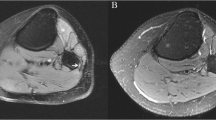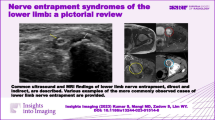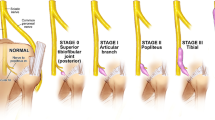Abstract
The soleus sling has been recently identified as a site of compression of the tibial nerve resulting in tibial neuropathy. Diagnosis of soleal sling syndrome is difficult, and has been based mainly on clinical examination. Advances in MR imaging with high-resolution 3-Tesla scanners have made direct visualization of nerve pathology possible. With the use of high-resolution imaging and fat-suppression protocols, tibial nerve compression at the soleal fascial arch can be demonstrated in a subset of patients presenting with idiopathic tibial neuropathy. The purpose of this paper is to confirm the ability of MR imaging to demonstrate pathologic changes in the tibial nerve in patients presenting with soleal sling syndrome. Additionally, patients presenting with tibial neuropathy and ganglion cysts, both extra- and intraneural, were examined to determine if the site of compression corresponded to the region of the soleus sling. Nine patients were included in the study, two with idiopathic soleus sling syndrome, four with extraneural, and three with intraneural ganglion cysts. In the patients presenting with idiopathic soleus sling syndrome, MR imaging demonstrated a thickened soleus sling with T2 hyperintensity of the tibial nerve at the level of the sling and denervation changes in muscles of the posterior compartment of the leg. In patients with extraneural ganglion cysts, MR imaging demonstrated a “sandwich”-like compression of the tibial nerve between the cyst and the soleus sling with corresponding tibial nerve T2 hyperintensity and denervation change in posterior compartment muscles. No compression of the tibial nerve at the soleus sling was found in the intraneural ganglion population. We conclude that MR imaging is effective in demonstrating pathologic changes in the tibial nerve at the soleus sling. Based on the MRI findings, we also believe that the soleus sling is a component of the compression when patients present with extraneural ganglion cysts and tibial neuropathy near the knee; in these patients, we recommend release of the soleus sling as part of the definitive management.




Similar content being viewed by others
References
Williams EH, et al. Soleal sling syndrome (proximal tibial nerve compression): results of surgical decompression. Plast Reconstr Surg. 2012;129(2):454–62.
Chhabra A, et al. MR neurography: past, present, and future. AJR Am J Roentgenol. 2011;197(3):583–91.
Chhabra A, et al. MR neurography findings of soleal sling entrapment. AJR Am J Roentgenol. 2011;196(3):W290–7.
Williams EH, et al. Anatomic site for proximal tibial nerve compression: a cadaver study. Ann Plast Surg. 2009;62(3):322–5.
Shahid KR, et al. Evaluation of intraneural ganglion cysts using three-dimensional fast spin echo-cube. J Magn Reson Imaging. 2010;32(3):714–8.
Ji JH, et al. Compressive neuropathy of the tibial nerve and peroneal nerve by a Baker’s cyst: case report. Knee. 2007;14(3):249–52.
Upton AR, McComas AJ. The double crush in nerve entrapment syndromes. Lancet. 1973;2(7825):359–62.
Jacobson JA, et al. Ulnar nerve dislocation and snapping triceps syndrome: diagnosis with dynamic sonography—report of three cases. Radiology. 2001;220(3):601–5.
Acknowledgments
The authors appreciate the assistance of David Factor, Rochester, MN.
Author information
Authors and Affiliations
Corresponding author
Rights and permissions
About this article
Cite this article
Ladak, A., Spinner, R.J., Amrami, K.K. et al. MRI findings in patients with tibial nerve compression near the knee. Skeletal Radiol 42, 553–559 (2013). https://doi.org/10.1007/s00256-012-1571-6
Received:
Revised:
Accepted:
Published:
Issue Date:
DOI: https://doi.org/10.1007/s00256-012-1571-6




